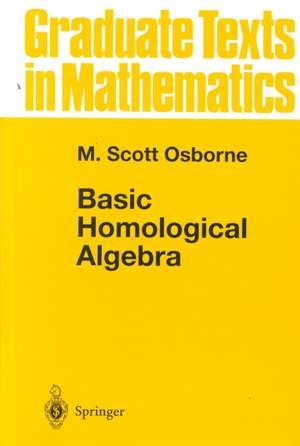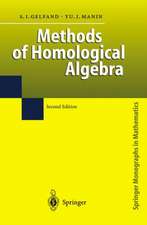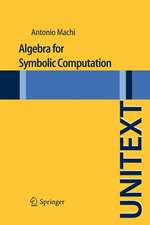Basic Homological Algebra: Graduate Texts in Mathematics, cartea 196
Autor M. Scott Osborneen Limba Engleză Hardback – 19 mai 2000
| Toate formatele și edițiile | Preț | Express |
|---|---|---|
| Paperback (1) | 494.48 lei 6-8 săpt. | |
| Springer – 18 sep 2012 | 494.48 lei 6-8 săpt. | |
| Hardback (1) | 595.21 lei 6-8 săpt. | |
| Springer – 19 mai 2000 | 595.21 lei 6-8 săpt. |
Din seria Graduate Texts in Mathematics
-
 Preț: 402.89 lei
Preț: 402.89 lei - 17%
 Preț: 528.68 lei
Preț: 528.68 lei -
 Preț: 337.46 lei
Preț: 337.46 lei -
 Preț: 383.86 lei
Preț: 383.86 lei - 17%
 Preț: 366.57 lei
Preț: 366.57 lei - 17%
 Preț: 398.97 lei
Preț: 398.97 lei -
 Preț: 355.83 lei
Preț: 355.83 lei -
 Preț: 411.84 lei
Preț: 411.84 lei -
 Preț: 404.48 lei
Preț: 404.48 lei -
 Preț: 289.88 lei
Preț: 289.88 lei - 17%
 Preț: 365.80 lei
Preț: 365.80 lei - 17%
 Preț: 359.45 lei
Preț: 359.45 lei - 15%
 Preț: 488.70 lei
Preț: 488.70 lei - 13%
 Preț: 357.76 lei
Preț: 357.76 lei -
 Preț: 407.88 lei
Preț: 407.88 lei - 13%
 Preț: 352.49 lei
Preț: 352.49 lei - 13%
 Preț: 358.86 lei
Preț: 358.86 lei - 13%
 Preț: 393.48 lei
Preț: 393.48 lei - 11%
 Preț: 351.00 lei
Preț: 351.00 lei - 17%
 Preț: 359.58 lei
Preț: 359.58 lei -
 Preț: 350.46 lei
Preț: 350.46 lei - 8%
 Preț: 567.37 lei
Preț: 567.37 lei -
 Preț: 399.74 lei
Preț: 399.74 lei -
 Preț: 498.91 lei
Preț: 498.91 lei - 20%
 Preț: 571.26 lei
Preț: 571.26 lei - 15%
 Preț: 546.59 lei
Preț: 546.59 lei -
 Preț: 498.69 lei
Preț: 498.69 lei - 15%
 Preț: 354.39 lei
Preț: 354.39 lei -
 Preț: 313.11 lei
Preț: 313.11 lei - 13%
 Preț: 427.40 lei
Preț: 427.40 lei - 17%
 Preț: 363.60 lei
Preț: 363.60 lei -
 Preț: 340.19 lei
Preț: 340.19 lei - 17%
 Preț: 364.47 lei
Preț: 364.47 lei - 17%
 Preț: 366.47 lei
Preț: 366.47 lei - 17%
 Preț: 366.07 lei
Preț: 366.07 lei -
 Preț: 247.59 lei
Preț: 247.59 lei - 17%
 Preț: 367.70 lei
Preț: 367.70 lei - 13%
 Preț: 356.80 lei
Preț: 356.80 lei - 17%
 Preț: 398.78 lei
Preț: 398.78 lei - 17%
 Preț: 398.51 lei
Preț: 398.51 lei - 17%
 Preț: 496.65 lei
Preț: 496.65 lei - 13%
 Preț: 361.80 lei
Preț: 361.80 lei - 15%
 Preț: 482.97 lei
Preț: 482.97 lei -
 Preț: 402.02 lei
Preț: 402.02 lei - 17%
 Preț: 366.57 lei
Preț: 366.57 lei - 20%
 Preț: 449.74 lei
Preț: 449.74 lei -
 Preț: 380.35 lei
Preț: 380.35 lei
Preț: 595.21 lei
Preț vechi: 700.25 lei
-15% Nou
Puncte Express: 893
Preț estimativ în valută:
113.91€ • 118.48$ • 94.04£
113.91€ • 118.48$ • 94.04£
Carte tipărită la comandă
Livrare economică 14-28 aprilie
Preluare comenzi: 021 569.72.76
Specificații
ISBN-13: 9780387989341
ISBN-10: 038798934X
Pagini: 398
Ilustrații: X, 398 p.
Dimensiuni: 155 x 235 x 24 mm
Greutate: 0.73 kg
Ediția:2000
Editura: Springer
Colecția Springer
Seria Graduate Texts in Mathematics
Locul publicării:New York, NY, United States
ISBN-10: 038798934X
Pagini: 398
Ilustrații: X, 398 p.
Dimensiuni: 155 x 235 x 24 mm
Greutate: 0.73 kg
Ediția:2000
Editura: Springer
Colecția Springer
Seria Graduate Texts in Mathematics
Locul publicării:New York, NY, United States
Public țintă
GraduateCuprins
1 Categories.- 2 Modules.- 2.1 Generalities.- 2.2 Tensor Products.- 2.3 Exactness of Functors.- 2.4 Projectives, Injectives, and Flats.- 3 Ext and Tor.- 3.1 Complexes and Projective Resolutions.- 3.2 Long Exact Sequences.- 3.3 Flat Resolutions and Injective Resolutions.- 3.4 Consequences.- 4 Dimension Theory.- 4.1 Dimension Shifting.- 4.2 When Flats are Projective.- 4.3 Dimension Zero.- 4.4 An Example.- 5 Change of Rings.- 5.1 Computational Considerations.- 5.2 Matrix Rings.- 5.3 Polynomials.- 5.4 Quotients and Localization.- 6 Derived Functors.- 6.1 Additive Functors.- 6.2 Derived Functors.- 6.3 Long Exact Sequences—I. Existence.- 6.4 Long Exact Sequences—II. Naturality.- 6.5 Long Exact Sequences—III. Weirdness.- 6.6 Universality of Ext.- 7 Abstract Homologieal Algebra.- 7.1 Living Without Elements.- 7.2 Additive Categories.- 7.3 Kernels and Cokernels.- 7.4 Cheating with Projectives.- 7.5 (Interlude) Arrow Categories.- 7.6 Homology in Abelian Categories.- 7.7 Long Exact Sequences.- 7.8 An Alternative for Unbalanced Categories.- 8 Colimits and Tor.- 8.1 Limits and Colimits.- 8.2 Adjoint Functors.- 8.3 Directed Colimits, ?, and Tor.- 8.4 Lazard’s Theorem.- 8.5 Weak Dimension Revisited.- 9 Odds and Ends.- 9.1 Injective Envelopes.- 9.2 Universal Coefficients.- 9.3 The Künneth Theorems.- 9.4 Do Connecting Homomorphisms Commute?.- 9.5 The Ext Product.- 9.6 The Jacobson Radical, Nakayama’s Lemma, and Quasilocal Rings.- 9.7 Local Rings and Localization Revisited (Expository).- A GCDs, LCMs, PIDs, and UFDs.- B The Ring of Entire Functions.- C The Mitchell—Freyd Theorem and Cheating in Abelian Categories.- D Noether Correspondences in Abelian Categories.- Solution Outlines.- References.- Symbol Index.
Recenzii
“Each chapter contains a reasonable selection of exercises. … its intended audience is second or third year graduate students in algebra, algebraic topology, or other fields that use homological algebra. … the author’s style is both readable and entertaining … . All in all, this book is a very welcome addition to the literature.” (T.W.Hungerford, zbMATH 0948.18001, 2022)
EMS Newsletter, June 2001












